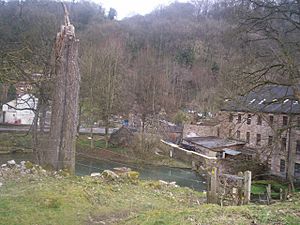Via Gellia facts for kids
The Via Gellia is a road and a beautiful valley in Derbyshire, England. It's known for its steep, wooded sides. This area is often called a "dry valley" because it doesn't have a river flowing through it all the time.
The road probably got its name from Phillip Eyre Gell. He was the person who built the road through this valley. The Gell family thought they were related to ancient Romans, so they gave the road a fancy, Latin-sounding name.
At one end of the Via Gellia, you'll find the village of Cromford. This village is close to the town of Wirksworth. Cromford is famous for the Cromford Mill, an old cotton factory built by a clever inventor named Richard Arkwright. At the other end of the valley is a small village called Grangemill.
Why Was the Road Built?
The Via Gellia road, which is now called the A5012, was built around 1790. The Gell family owned many lead mines around Wirksworth. They needed a way to get the lead from their mines to a new place where it could be melted down in Cromford. So, they built this road to connect the mines to the smelter.
Some people think the road was used even earlier, around 1720. They believe it helped transport stone from the Gell family's quarries near Hopton. So, the road was important for moving both lead and stone.
Viyella Fabric Connection
Have you ever heard of the fabric called Viyella? It's a special mix of wool and cotton. This fabric was named after the Via Gellia valley! It was first made at a textile factory belonging to W. Hollins & Company, which was located right here in the valley.
Road Safety Today
In more recent times, the Via Gellia became known as a road where many accidents happened. This was especially true for people riding motorcycles. There were a few reasons for this. The road is quite narrow, and many large trucks use it to reach nearby quarries. Also, lots of trees hang over the road, which can make the surface damp and slippery, even when it hasn't rained much.
To make the road safer, the local council in Derbyshire did some work in 2006. They resurfaced the road, which means they put a new, smoother layer on top. These changes helped to improve safety for everyone using the Via Gellia.


